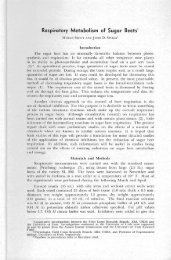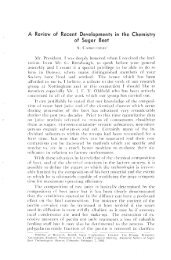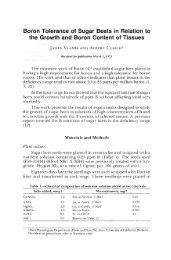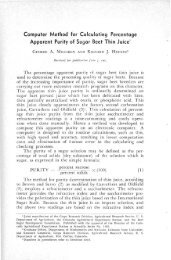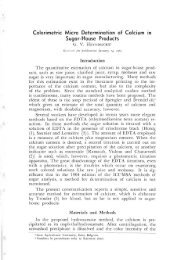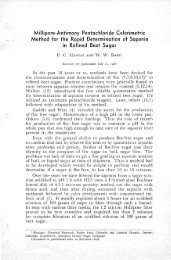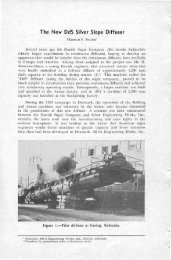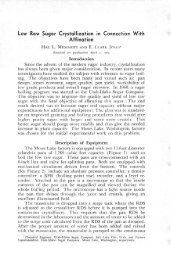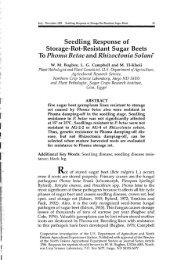Journal of Sugar Beet Research - Vol
Journal of Sugar Beet Research - Vol
Journal of Sugar Beet Research - Vol
Create successful ePaper yourself
Turn your PDF publications into a flip-book with our unique Google optimized e-Paper software.
January - June 2008 <strong>Sugar</strong>beet Response to Nitrogen 21<br />
A sugarbeet crop under sprinkler irrigation on clay soil appears to<br />
need less nitrogen because less N is lost to leaching and run<strong>of</strong>f. The<br />
objective <strong>of</strong> this study was to evaluate sugarbeet response to varying<br />
rates <strong>of</strong> nitrogen under sprinkler and furrow irrigation.<br />
MATeRIALS AnD MeThoDS<br />
The study was conducted from 2003-2006 at the Montana State<br />
University Eastern Agricultural <strong>Research</strong> Center in Sidney, MT. Soil is<br />
a fine smectitic frigid Vertic Argiustolls (Savage silty clay). Average<br />
growing season (April-August) precipitation is 27.3 cm. In the fall<br />
prior to each spring planting season, the site was irrigated, plowed,<br />
mulched twice and leveled. Residual soil N was measured to a depth<br />
<strong>of</strong> 120 cm in 30-cm increments, so that applied N rates could be determined.<br />
Soil NO 3 -N levels prior to N application for each year are shown<br />
in Table 1, along with previous crops, N application dates, planting<br />
dates, harvest dates, irrigation dates, and growing season precipitation<br />
for each year. In two years <strong>of</strong> the study, N was applied in the fall and<br />
immediately incorporated, while in the other two years, N was applied<br />
in the spring just prior to planting, and immediately incorporated. In all<br />
years, N was applied in the form <strong>of</strong> liquid N, 28-0-0.<br />
Nitrogen rates were randomized with 6 replications under each<br />
irrigation system. Nitrogen was applied at rates so that available N,<br />
including residual soil N, to 120 cm was 112, 141, 169, 197, and 225 kg<br />
N/ha. A check treatment with no applied N was included.<br />
Irrigation systems were next to each other in the field, but separated<br />
by 15 rows <strong>of</strong> sugarbeet, to avoid influence <strong>of</strong> one irrigation system on<br />
the other. Rows were 60 cm wide. Each irrigation treatment was 72<br />
rows wide, with six replications <strong>of</strong> each N treatment. Furrow irrigation<br />
was administered using gated pipe, and sprinkler irrigation was an<br />
overhead, low-pressure system. Furrow irrigation delivered 7.6 cm <strong>of</strong><br />
water with each application, and sprinkler irrigation delivered 2.5 – 3.0<br />
cm with each application. The two irrigation systems were previously<br />
compared and shown to result in different quality <strong>of</strong> sugarbeet when<br />
the same N rate was used (Eckh<strong>of</strong>f et al. 2005). In the current study,<br />
irrigation systems were not compared, but N rates within each irrigation<br />
system were compared.<br />
<strong>Sugar</strong>beet was planted to stand at a rate <strong>of</strong> one seed every 10 cm<br />
(Eckh<strong>of</strong>f et al, 1991) using a commercial six-row planter with 60 cm<br />
between rows. The variety was American Crystal Hybrid 927. When<br />
seedlings were in the two- to four-leaf growth stage, plots were trimmed<br />
so that plots were 11 m long and six rows wide. Plots were not thinned.



